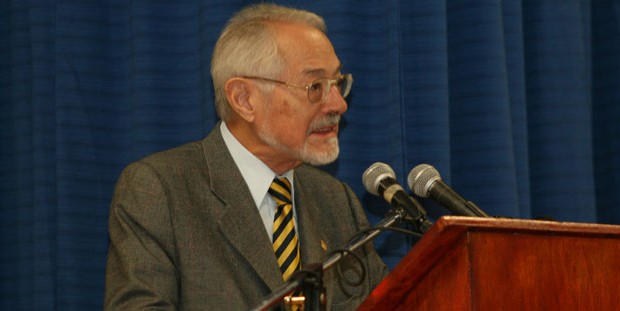Editing Journals across Languages and Cultures
A través de las lenguas y culturas - Profesión: editor de revistas
Rose Mary Salum
The history of modern literature is often confused
in Europe and the Americas with the
history of literary journals.
OCTAVIO PAZ
It might not be obvious to many but academic journals, through their continuous serial publication, knit a fine, yet extensive web of language that flows like a nervous system through society, connecting readers to multiple states of intellectual awareness and vibrant potentiality. The work of journal editing in language and literature studies interlaces a collective dialogue that takes place across all the issues of a journal, between other journals, and just as importantly, within and among different nations. A multilingual journal constructs a palpable cultural viaduct, allowing intellectual and literary production to flow into new spaces in other cultures, creating alertness on both ends, for translations transcend the barriers of language. In this increasingly global way of life, multilingual journals are the catalysts of cultural fusion and assimilation, the place were translation becomes the lattice supporting the growth of the concept of otherness. However, I often wonder to what extent this observation is applicable to journals published in the United States, for editing across language and culture divides is such a scarce activity in this country. I wish to trace some of the forces that impede editing across the divide between English and other languages—particularly Spanish.
Be it print or virtual, literary expression, in becoming art, signals the robustness of a society. A journal of letters manifests culture. In a periodical dedicated to the humanities, art uses language as its means of expression. Nevertheless, language itself can get in the way of art. As an editor of a bilingual journal, Literal: Latin American Voices, I encounter this challenge on a daily basis, something that is of minor concern to other advocates of art such as museum curators or music directors. And that is because Literal works as a threshold where foreign forms of expression cross. Literal aspires to promote a vibrant, contemporary view on Latin and American cultural engagement and exchange. The journal provides an international medium for the diffusion of current events, literature and art in Mexico, the US, and Canada; some of the articles are presented in English and Spanish side by side, while others are presented in Spanish or English alone. Literal understands that the broad cultural universe cannot be limited by any single language.
This multi awarded publication, is a driven mission journal that seeks to build a dense bridge able to hold a two way cultural dialogue between North and South America—being that the reason we publish it in Spanish and English. It brings out essays, interviews, art, photography, art critic, works of fiction, reviews and poetry.
Juggling languages in our pages has made us understand that language can sometimes be the agent of fate; a language determines and is determined by the structures that constrain and support it. An Anglo-American will never articulate in the same way an Argentinean will, because each language has a structure that impinges on expression, or as Doris Sommer has said, “Each language constitutes a distinct ‘psyche of a people’” (Bilingual Aesthetics 10). While visual or acoustic artistic expressions may readily target an international public, transcending barriers of language difference, if not always cultural difference, this will never occur in print without the help of translation. Disciplines like the visual or acoustic arts are not so heavily burdened with such need for intervention. In his Syntactic Structures, Noam Chomsky considers the variation of natural languages to be quite superficial (85–92). Following Chomsky’s train of thought, what is published in a bilingual journal will need to overcome the superficial structures of language. There is no question about the feasibility of such a venture, but rather about who will have the capacity to translate, who will invest in the necessary tools to enrich the vast cultural landscape that exists beyond the Anglo-speaking American world.
Things are liable to become more complicated, however, for the text is not all that needs to be translated. One is faced with the responsibility of trying to translate culture. The nongeographical place where language and culture meet in journal discourse must be inhabited by an attentive editor. Written expressions need to pass through this space on the way from one language to another to make an idea, an image, or a metaphor understandable. Insofar as this can be done, editors, along with artists, become architects of linguistic and cultural change. Now, an expression in one language cannot be completely transmitted into another language. The question, and challenge, is about how much of a culture can be transmitted into another language, and how much an editor should intervene in trying to make that happen.
This is exactly where the difficulties of working with authors whose first language is not English begin. I will not go into the technicalities of translating, but some readers agree with Norman Shapiro when he says that any translated text should be “so transparent that it does not seem to be translated. A good translation is like a pane of glass. You only notice that it’s there when there are little imperfections—scratches, bubbles. Ideally, there shouldn’t be any. It should never call attention to itself” (qtd. in Venuti, Translator’s Invisibility 1). Shapiro’s belief in the lucid translation is attractive, and may be true on the level of reading a translation, but few would agree that translation is a transparent process, that a translation functions simply as one culture’s clear window into another one. Opposing this theory is Doris Sommer, a scholar who positively celebrates the necessary imperfections of crossings from one language to another: “Words are not proper and don’t stay put. They wander into adjacent language fields, get lost in translation, pick up tics from foreign interference, and so can’t quite mean what they say” (Bilingual Aesthetics 12). At Literal, we struggle with these issues and end up agreeing with editors like Samantha Schnee, of Words Without Borders, who thinks that “the translation must be faithful to the source text but must also be rendered naturally into the new language” (Salum). Or with Isabel Fargo Cole, editor of No Man’s Land: “The important thing is that the translation should have as much ‘life’—tension and energy—as the original, and the translator really has to recreate this in his or her own terms” (Salum). What is truly important to a journal like Literal, which publishes in a bilingual format, is that from beginning to end language and translation can surpass outdated or stagnant forms of thought and offer new avenues for unveiling the human spirit.
To this end, an editor of a bilingual publication seeking to foster a dialogue between cultures becomes a mediator, a “translator” of culture. As Mary Louise Pratt suggests, anything related to languages might best be taken as an exercise in “cultural translation.” What is usually thought of as an “editorial intervention” turns into a “cultural invention.” The traditional editorial tendency, when selecting the contents of a journal, to search inside a native language rather than investigate outside of it, and to be conservative rather than inventive, needs to be closely scrutinized. It is a mistake—a common and tempting one—to repeat ad infinitum what has already been safely presented by the media, or even worse, to perpetuate a stereotype of a country’s culture. Neither can the editor be discouraged by the lack of knowledge, say, of what the vast world of literature written in Spanish has to offer. So the question arises, should a journal like Literal promote established writers familiar to readers and thereby minimize the risk of failure? I believe the editor should move out of the comfort zone of fame and predictability. Editing across languages is more compelling from a decentered position in relation to the dominant culture, when there is a “dance” between the core and the perimeter of a culture. Should we keep translating Carlos Fuentes, Mario Vargas Llosa, or Roberto Bolaños so we can be identified as a journal that is in the know, or should we bet on extablished yet unfamiliar voices in the Spanish-speaking world along with new voices pushing from the underground to be heard? Should we translate only those writers likely to be well received within the Anglo-speaking world? Should we let the author’s work speak with minimal interference? Or should I as an editor intervene in the translation when I worry about the text’s ability to communicate in a different culture? If so, what can I do to make it feasible for readers to comprehend what this person has to say? Do I need to supply a specific context in a note so the author can be understood? Am I a co-creator by the mere fact that I facilitated the author’s accessibility to the new audience? Is it possible for a bilingual journal to separate the function of translation from the function of editing? These are questions that cannot be answered purely by reason; they require an almost corporeal, yet intuitive perception of culture. With this statement I mean that each case needs to be approached accordingly. However, I need to emphasize that an editor should balance the raison d’être of every case. Therefore, yes, we need to keep translating Bolaños, Fuentes, Vargas Llosa, but also the unknown, yet quality voices that are continuously arising by letting the author’s work speak with minimal interference. If a case turns out to be unique, Literal could supply a specific context in a note so the author could be understood—and always safeguarding its virtues in the face of edits and revisions. Nonetheless, an editor should never be intimidated by the response of the readers. There are innumerable cases in the history of literature and art, that creators were not understood by their fellow contemporaries Consequently the dance is always there; we try to hold the tension of the opposites, hoping for a synthesis that will provide the best passage to meaningful cross-cultural dialogue.
So editors invite to the common table voices that otherwise would remain silent. In search of new connections in the complicated web of international dialogue, the editor of a bilingual journal reads the signs of where human thought is headed and then brings harbingers of the new into dialogue with the established culture. We know we can’t ignore the globalized world where influences roam freely, even if the American public tends not to recognize the presence of other cultures within its own borders. As Samantha Schnee puts it in a recent interview, “As the world’s population increases and national economies morph into a global economy to a greater degree, events outside US borders will affect the US more deeply and more frequently” (Salum). But as this change is happening, there is a growing concern among certain critics that current scholarship in the field of cultural studies is inadequate for the task of addressing the significance of globalization on local regions and cultures. Moreover, “There is a tendency to abstract and aestheticize the colossal displacement of peoples and their cultures generated by globalization,” explains Lorraina Pinnell in her review of the book Global/Local: Cultural Production and the Transnational Imaginary (205). A hybrid journal like Literal has a special role in addressing, in concrete terms and forms, cross-cultural contacts whirling through Canada, the US, and Latin America. For our part, we are dedicated to resisting this tendency to abstract an entire reality; the pages of Literal present distinct regions of the Americas in their various and sometimes clashing embodiments.
A sign of an effervescent nation is the welcoming of writers and artists from all over the world in dialogue, and journals are the primary hosts. In Europe, Geoffrey Faber, Helen Wolf, Joan Grijalbo, Jorge Herralde, Carlos Seix Barral, just to mention few visionary editors, are bringing authors from many nations and cultures to their readers. The US, by contrast, hosts just a few journals that routinely translate works from other cultures into English, such as Absinthe: New European Writing, Aufgabe, Calque, CipherJournal, Circumference, Hofstra Review, No Man’s Land, Onedit, Parthenon West Review, Pratilipi, The Raven Chronicle, Tameme, Words Without Borders, and Literal: Latin American Voices; and still fewer journals in the US are dedicated to publishing translated poetry, such as Two Lines or Modern Poetry in Translation. Of all these journals, only a few translate from or into Spanish. The translator and editor of Tameme C. M. Mayo remarks that “Mexican literature—a vast banquet—is one of the greatest achievements of the Americas. And yet we who read in English go hungry, for so astonishingly little of it has been translated. This is more astonishing still when one considers that the United States shares a two thousand-mile-long border with Mexico” (x). Esther Allen sharply says in a PEN American Center report that “English all too often simply ignores whatever is not English” (“English as an Invasive Species”). Despite the few lights mentioned above, the lack of venues for translation can be demoralizing.
Working across languages as a journal editor inevitably involves battling the establishment, standing in opposition to what might be considered “the best” by the general public—specifically corporate-sponsored authors on best-seller lists. Indeed, journals are the places where writers appear before they are judged by the general public as being “good.” While established writers with book contracts do continue to publish in journals, the “translation” journal has a critical mission to shelter struggling, often provocative voices from other countries, to draw a new geography onto the map of literature. Translations, however, are not as welcome in the US market as in many other cultures. “Ours is an export culture,” notes Esther Allen, observing that US artistic expressions are read and seen in the rest of the world while this country does not have a clear idea of what is being produced outside of its borders (“Confessions of a Silent Genre”). Lukas Klein, editor of CipherJournal, agrees: “Politically, culturally, historically, the US has been very insular and self-satisfied. . . . Of course this has changed, and the rush of immigration in the last several decades continues to change it further. But culturally, Americans’ interest in other cultures and other languages often gets under-encouraged” (Salum). I once was invited to a conference at a book fair in Mexico City and was asked why I publish Literal bilingually in a culture that is clearly monolingual. I answered, “Because Latin Americans also produce first-class literary and artistic material that needs to be known in the rest of the world.” But Lawrence Venuti’s view of the situation is disturbing: “It can be said that Anglo-American publishing has been instrumental in producing readers who are aggressively monolingual and culturally parochial while reaping the economic benefits of successfully imposing Anglo-American cultural values on a sizeable foreign readership” (Rethinking Translation 6). The dominance of corporate book-selling and the resulting cultural insulation of most of our public argues precisely for the critical role played by journals. Many voices cannot ever be heard in the marketplace except in a journal.
The obstacles, therefore, are enormous; the pressures are often asphyxiating. An editor across languages understands the daunting task of bringing new voices and other languages into the marketplace of American culture, especially confrontational voices. Yet these same editors embrace their responsibility, no matter how long it will take to see a transformation in the reading public. Jana Argersinger and Michael Cornett describe the situation of editors of bilingual journals perfectly when they say, “The professional life of the humanities journal editor, as it stands, is a curious blend of influence and invisibility” (from the introduction to this special section of Profession).
In a society so immersed in celebrity and popularity, it is vital that journal publishing pay attention to forms of non-English-speaking creative and intellectual expression, especially in Spanish. We need an environment in which we are able to connect with the human spirit, no matter its ethnicity, for living in a global world obliges us. As I said at the beginning, multilingual journals are the catalysts of cultural fusion and assimilation, the place were translation becomes the lattice supporting the growth of the concept of otherness. If America wants to flourish as a leader in the world of literature and the humanities, the publishers will have to become more open to works in translation, to compelling voices whose native tongue might be unintelligible to most Americans, but which can be heard and listened to in translation.
La historia de la literatura moderna,
en Europa y en América, se confunde muchas veces
con la de las revistas literarias.
OCTAVIO PAZ
Quizá no sea obvio para muchos pero las revistas culturales, en tanto que sus publicaciones periódicas, tejen una delicada (y sin embargo extensa) red de palabras, que se infiltra en la sociedad como un sistema nervioso, conectando lectores a múltiples estados de conciencia intelectual. El trabajo de edición en una revista bilingüe entreteje un diálogo colectivo en cada una de sus entregas, entre otras revistas y entre naciones. Una revista multilingüe construye un palpable viaducto cultural que permite que la producción intelectual y literaria fluya dentro de nuevos espacios en otras culturas, creando un nuevo estado de conciencia, ya que las traducciones trascienden las barreras del idioma. En un estilo de vida cada vez más global, las revistas multilingües son el catalizador de una fusión y asimilación culturales; el lugar donde la traducción se convierte en un entramado que apoya el crecimiento del concepto de otredad. Sin embargo, con frecuencia me pregunto hasta qué punto esta observación puede aplicarse a las revistas publicadas en Estados Unidos, dado que la edición a través de las líneas divisorias del idioma y la cultura es una actividad tan escasa en este país. Me gustaría rastrear algunos de los obstáculos que se presentan justo en esa línea divisoria entre el inglés y otras lenguas, particularmente el español.
Ya sea impresa o virtual, la expresión literaria, al convertirse en arte, muestra la fortaleza cultural de una sociedad. Una revista de literatura manifiesta la cultura. En una publicación dedicada a las humanidades, el arte usa el idioma como su medio de expresión. Sin embargo, éste puede llegar en forma de arte. Como editora de Literal. Latin American Voices, yo me encuentro con este reto de manera cotidiana –algo que resulta ser de poco interés para otros defensores del arte, como curadores de museos y directores de música–. Esto sucede porque Literal funciona como un umbral donde las formas extranjeras de expresión se cruzan. Literal aspira a promover una visión contemporánea del intercambio cultural entre Latinoamérica y Norteamérica.
Lidiar con la expresión bilingüe en esas páginas nos ha hecho entender que el idioma a veces puede determinar y ser determinado por las estructuras que la delinean y sostienen. Un angloamericano nunca articulará de la misma manera en que lo hará un argentino porque cada idioma tiene una estructura que constriñe su propia expresión. Como dijo Doris Sommer: “Cada lengua constituye la distintiva ‘psique de un pueblo’” (Bilingual Aesthetics 10). Mientras que las expresiones visuales y acústicas pueden dirigirse fácilmente a un público internacional, trascendiendo las barreras del idioma, esto nunca sucedería en las expresiones escritas sin la ayuda de la traducción. Las disciplinas artísticas, como la visual y la acústica, no están tan cargadas de dicha necesidad de intervención. En su libro Estructuras Sintácticas, Noam Chomsky considera que la variación de las lenguas naturales es bastante superficial (85-92). Siguiendo la misma línea de pensamiento de Chomsky, lo que se publica en una revista bilingüe necesitará superar las estructuras superficiales de la lengua. No hay duda de la viabilidad de tal empresa, sino de quién tendrá la capacidad de traducir, quién invertirá en las herramientas necesarias para enriquecer el vasto panorama cultural que existe más allá del mundo angloparlante.
Sin embargo, es probable que las cosas se vuelvan más complicadas ya que el texto no es todo lo que necesita ser traducido. Uno se enfrenta a la responsabilidad de intentar traducir la cultura. El lugar no-geográfico donde el idioma y la cultura se unen en el discurso de las revistas debe ser dirigido por un editor atento. Las expresiones escritas necesitan pasar por este espacio en su camino de una lengua a otra para crear una idea, una imagen o una metáfora inteligible. En la medida en que esto pueda realizarse, los editores junto con los artistas, se vuelven arquitectos de un cambio lingüístico y cultural. Ahora bien, una expresión en una lengua no puede ser completamente transmitida en otra. El reto es cuánto se puede trasladar de una cultura a otro idioma, y de cuánto un editor debe intervenir al intentar que esto suceda.
Es exactamente aquí donde comienzan las dificultades de trabajar con autores cuya primera lengua no es el inglés. No entraré en detalles técnicos de traducción, pero algunos lectores coinciden con Norman Shapiro cuando dice que cualquier texto traducido “debe ser tan transparente que no parezca haber sido traducido. Una buena traducción es como un cristal. Sólo te das cuenta de que está ahí hasta que notas pequeñas imperfecciones; rayones, burbujas. Idealmente no debería existir ninguna. Nunca debería llamar la atención por sí misma” (citado en Venuti, La invisibilidad del traductor 1). La idea de Shapiro sobre la traducción lúcida es atractiva y tal vez sea cierta cuando se lee una traducción, pero pocos estarían de acuerdo en que ésta es un proceso transparente, que funciona como la clara ventana que separa a una cultura de otra. En oposición a esta teoría está Doris Sommer, una académica que celebra positivamente las imperfecciones necesarias en los cruces entre un idioma y otro: “Las palabras no son correctas y tampoco permanecen en la misma posición. Deambulan por campos del lenguaje adyacentes, se pierden en la traducción, adoptan tics de la interferencia extranjera y por lo tanto nunca pueden significar lo que quieren decir” (Bilingual Aesthetics 12).
En mi trabajo lidio cotidianamente con estos temas y acabo por coincidir con editores como Isabel Fargo Cole, editora de No Man’s Land: “Lo importante es que la traducción debe tener tanta `vida´ –tensión y energía– como el original, y el traductor debe recrearla en sus propios términos” (Salum). Lo que es verdaderamente importante para una revista como Literal, publicada en formato bilingüe, es que desde el comienzo hasta el final el idioma y la traducción pueden sobrepasar formas de pensamiento caducas o anquilosadas y ofrecer nuevas vías para revelar el espíritu humano.
Para lograrlo, el editor de una publicación bilingüe que busca fomentar un diálogo entre culturas se vuelve un mediador, un “traductor” de cultura. Tal como sugiere Mary Louise Pratt, cualquier cosa relacionada con la lengua debe ser tomada idealmente como un ejercicio de “traducción cultural”. Lo que comúnmente se piensa que es una “intervención editorial” se vuelve una “intervención cultural”. La tendencia editorial tradicional –aquella que selecciona los contenidos de una revista, que en lugar de buscar dentro de una lengua natural investiga fuera de ésta, y es conservadora más que ingeniosa– necesita ser inspeccionada en detalle. Es un error –común y tentador– repetir ad infinitum lo que ya ha sido presentado por los medios de comunicación, o peor aun: perpetuar el estereotipo de la cultura de un país. El editor tampoco puede desanimarse por la falta de conocimiento, digamos, de lo que el vasto mundo literario en español tiene que ofrecer. Entonces surge la pregunta de si una revista como Literal debería promover sólo escritores reconocidos para minimizar el riesgo de un fracaso. La edición a través de culturas es mucho más convincente desde una posición descentralizada en relación con la cultura dominante, cuando existe un “baile” entre el centro y la periferia de esa cultura. ¿Deberíamos continuar traduciendo a Carlos Fuentes, Mario Vargas Llosa o a Roberto Bolaño para poder ser identificados como una revista seria, o debemos apostarle a voces “menos instituidas” junto con nuevas plumas que empujan desde el subsuelo para ser escuchadas? ¿Debemos traducir sólo a aquellos escritores que posiblemente serán bien recibidos dentro del mundo angloparlante? ¿Debemos permitir que el trabajo del escritor hable con mínima interferencia? ¿O debo, como directora, intervenir en la traducción cuando me preocupa la habilidad del texto para expresar algo en una cultura diferente? Si es así, ¿qué puedo hacer para que sea factible para los lectores comprender lo que esta persona tiene que decir? Estas son preguntas que no pueden ser respondidas con simpleza; requieren de una percepción casi corpórea y hasta intuitiva de la cultura. Para hablar de manera específica, cada caso necesita ser abordado adecuadamente. No obstante, es importante enfatizar que un editor debe equilibrar la raison d’être de cada ejemplo. Por lo tanto, sí, necesitamos continuar traduciendo a Bolaño, Fuentes y Vargas Llosa, pero también a las voces desconocidas y de calidad que continuamente están surgiendo, dejando que el trabajo del escritor hable con una mínima interferencia. Si un caso resulta ser único, Literal podría proveer un contexto específico en una nota para que el autor pueda ser comprendido –siempre salvaguardando sus virtudes de cara a las ediciones y revisiones–. Pero un editor nunca debe verse intimidado por la respuesta negativa de los lectores. Hay ejemplos innumerables en la historia de la literatura y el arte en los cuales los creadores no fueron comprendidos por sus colegas contemporáneos. En ese sentido, el “baile” siempre está allí; tratamos de mantener la tensión de los opuestos, esperando una síntesis que ofrezca el mejor pasaje al diálogo.
Así, los editores invitan a la mesa de discusión a voces que de otra manera permanecerían en silencio. En la búsqueda de nuevas conexiones en la complicada red del diálogo internacional, el editor de una revista bilingüe lee las señales que indican a dónde se dirige el pensamiento humano y entonces promueve lo nuevo en la cultura establecida. Sabemos que no podemos ignorar el mundo globalizado donde las influencias deambulan libremente incluso si el público estadounidense tiende a no reconocer la presencia de otras culturas dentro de sus propias fronteras. Como dijo Samantha Schnee en una conversación que tuvimos recientemente: “Conforme crece la población mundial y las economías nacionales mutan hacia una economía global, los sucesos internacionales afectarán al país norteamericano más profundamente y con más frecuencia”. Pero conforme sucede este cambio, existe una creciente preocupación entre ciertos críticos de que la Academia en el área de estudios culturales es inadecuada en la tarea de dirigir el significado de la globalización en regiones y culturas locales. Además, “existe una tendencia a extraer y adornar el desplazamiento colosal de personas y sus culturas generadas por la globalización”, explica Lorraina Pincel en su reseña del libro Global/Local: Cultural Production and the Transnational Imaginary (205). Una revista de cultura como Literal juega un papel especial al dirigirse, en términos y formas concretas, a contactos trazados entre Canadá, Estados Unidos y Latinoamérica. Por nuestra parte, estamos dedicados a resistir esta tendencia, a extraer una realidad total; nuestras páginas presentan regiones distintivas de América en sus diversas –y algunas veces dispares– personificaciones.
Un signo de una nación efervescente es la bienvenida a escritores y artistas de todo el mundo que están en diálogo, y las revistas son sus principales anfitrionas. En Europa, Geoffrey Faber, Helen Wolf, Joan Grijalbo, Jorge Herralde, Carlos Seix Barral, solo por mencionar algunos editores visionarios, están llevando a sus lectores, escritores de muchas naciones y culturas. Estados Unidos, por el contrario, hospeda sólo pocas revistas que cotidianamente traducen trabajos de otras culturas al inglés, tal como Absinthe: New European Writing, Aufgabe, Calque, Chipre Journal, Circumference, Hofstra Review, No Man’s Land, Onedit, Parthenon West Review, Pratilipi, The Raven Chronicle, Tameme, Words Without Borders, y Literal: Latin American Voices. Existen mucho menos revistas en Estados Unidos dedicadas a publicar poesía traducida, tal como Two Lines o Modern Poetry in Translation. De todas estas, sólo algunas traducen de y al español. La directora de Tameme, C. M. Mayo, comenta que “la literatura mexicana –un vasto banquete– es uno de los grandes logros de América. Y aún así los que leemos en inglés pasamos hambre porque asombrosamente existen muy pocas traducciones. Esto es mucho más asombroso cuando uno considera que Estados Unidos comparte una frontera con México de dos mil millas”. Esther Allen dice, con agudeza, en un reporte del centro norteamericano PEN que “el inglés ignora con frecuencia cualquier cosa que no sea inglés” (“El inglés como una especie invasiva”). A pesar de algunas luces mencionadas anteriormente, la falta de espacios para la traducción puede ser desalentadora.
Trabajar a través de lenguas, como editor de revistas, inevitablemente involucra una batalla contra lo establecido, manteniéndose en oposición con lo que podría ser considerado “lo mejor”, por el público en general –especialmente los escritores patrocinados por las grandes casas editoriales en las listas de best sellers–. De hecho, las revistas son los lugares donde los escritores aparecen antes de ser juzgados como “buenos” por el público en general. Mientras que los escritores consolidados con contratos de libros continúan publicando en revistas, la revista que traduce tiene la misión crítica de acoger voces que luchan y a menudo inquietan, desde otros países, para dibujar una nueva geografía en el mapa de la literatura. Las traducciones, sin embargo, no son tan bienvenidas en el mercado estadounidense como en otras culturas. “Nuestra cultura es una cultura de exportación”, apunta Esther Allen, al observar que las expresiones artísticas de Estados Unidas son leídas y vistas en el resto del mundo mientras que este país no tiene una clara idea de lo que está siendo producido fuera de sus fronteras (“Confesiones de un Género Silencioso”). Lukas Klein, editor de Chipre Journal, me explicaba que: “Política, cultural e históricamente, Estados Unidos ha sido muy insular y pagado de sí mismo… Claro que esto ha cambiado, y la ráfaga de la inmigración en las últimas décadas continuará cambiándolo aún más. Pero culturalmente, el interés de Estados Unidos en otras culturas y otras lenguas queda desalentado”. Una vez fui invitada a una conferencia en una feria del libro en la Ciudad de México y me preguntaron por qué publicaba Literal en edición bilingüe en un país que es claramente monolingüe. Yo contesté: “Porque los latinoamericanos también producen material literario y artístico de primer nivel que necesita ser conocido en el resto del mundo”. Pero el punto de vista de Lawrence Venuti con respecto a esta situación es inquietante: “Puede decirse que las publicaciones angloamericanas han tenido un papel decisivo al producir lectores que son agresivamente monolingües y culturalmente provincianos, mientras cosechan los beneficios económicos de la imposición exitosa de los valores culturales angloamericanos a un número considerable de lectores extranjeros” (Rethinking Translation 6). La dominación de las ventas de libros por las grandes casas editoriales y el resultante aislamiento cultural de la mayor parte de nuestro público discute precisamente sobre el papel crítico que juegan las revistas. Muchas voces no pueden ser escuchadas en el mercado excepto en una revista.
Los obstáculos, por lo tanto, son enormes; las presiones son comúnmente asfixiantes. Un editor bilingüe entiende la tarea desalentadora de traer nuevas voces y otras lenguas al mercado cultural estadounidense, especialmente voces controvertidas. Sin embargo, un editor asume su responsabilidad, sin importar cuánto tiempo tomará para ver la transformación en el público lector. Jana Argersinger y Michael Cornett describen perfectamente la situación de los editores de revistas cuando dicen: “La vida profesional de los editores de las revistas de humanidades, tal como se encuentran actualmente, es una mezcla curiosa de influencia e invisibilidad”.
En una sociedad tan inmersa en las celebridades y la popularidad, es vital que las publicaciones de revistas pongan atención en formas de expresión creativas e intelectuales no-angloparlantes, especialmente en español. Necesitamos un entorno en donde seamos capaces de conectar con el espíritu humano, sin importar su origen étnico, ya que el mundo global nos obliga a hacerlo. Como mencioné al principio, las revistas multilingües son los catalizadores de la misión y asimilación culturales; el lugar donde la traducción se vuelve el entramado que apoya el crecimiento del concepto de otredad. Si Estados Unidos quiere florecer como un líder en el mundo literario y de las humanidades, los editores tendrán que abrirse a los trabajos en traducción, a las voces convincentes, cuya lengua materna podría ser ininteligible para la mayoría de los norteamericanos, pero que pueden ser escuchados gracias a la intervención de un traductor.










